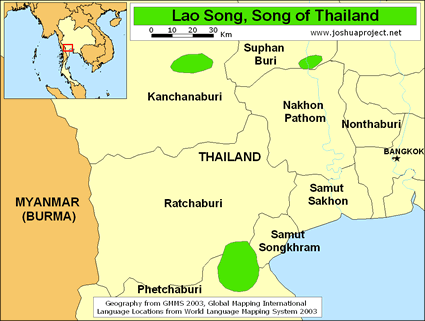The renowned researcher Erik Seidenfaden first noted the existence of the Song people in the 1950s. He discovered that they were originally Tai Dam (Black Tai) people who were forcibly moved to Thailand from their homeland east of the town of Luang Prabang in Laos.
Joachim Schliesinger adds: "in the late eighteenth and nineteenth centuries, the Siamese armies raided the region several times and took tens of thousands of Tai Dam people to Thailand as war captives. The first Siamese military involvement in that area occurred in the early 1780s, extending to the late nineteenth century. Most of the Lao Song arrived in Thailand in two major waves. The first wave was taken as war captives by the Siamese army during the time of King Phra Nangklao (1824–1851). The second arrived in the 1870s." The captives were made to work on construction projects and also had to defend the court against frequent Chinese raids at the time. Consequently, they spread out over a wide area of Thailand, from Phitsanulok Province in the north to Chumphon in southern Thailand, a distance of almost one thousand kilometres (620 mi.).
Although ethnically and linguistically the Song have been shown to be a branch of the large Tai Dam ethnicity, they now have their own identity and sense of cohesiveness that qualify them as a separate people group. Today "the descendants of the Tai Dam captives do not consider themselves as Tai Dam but as Lao Song. Song identity is now defined in part by a common recognition of a distinct historic experience and common opposition to the dominant culture and political society following relocation."
The Lao Song ethnic group inhabit a widespread area in central Thailand. They are distributed in the eight provinces of Phetchabun, Phitsanulok, Nakhon Sawan (Tha Tako District), Ratchaburi (Chom Bung District), Suphan Buri (Song Phinong District), Kanchanaburi, Chumphon and Nakhon Pathom (Muang District).
Lao Song women wear a distinctive traditional costume consisting of a dark blue dress with white, bright blue or yellow vertical stripes. Until the 1980s the Lao Song refused to intermarry with people from outside their group, but in recent years this has relaxed, and they now intermarry freely with Thai, Isan and Chinese people.
One of the major characteristics that sets the Lao Song apart from the Tai Dam is religion. While most Tai Dam in Laos, Vietnam and China are animists, the Lao Song in Thailand have overwhelmingly converted to Theravada Buddhism, although they still retain many of their traditional beliefs as well. Every Song village has its own shaman, called mo sen, who acts as a mediator between the people and the spirits.
Throughout the course of many generations since their ancestors first arrived in Thailand, the Song people have lived and died with very few of their number ever having heard of Jesus Christ. Today, less than one per cent of Song people are Christian believers.
Pray for workers to go to the Lao Song people, and for their hearts to be ready to receive their Savior.
Pray for families of believers loving and serving others to grow reproducing churches.
Pray for a chain reaction of families reaching families that results in thousands of new believers who share their faith with others.
Pray for grace and truth expanding into their entire society as all believers learn to love others.
Scripture Prayers for the Lao Song in Thailand.
| Profile Source: Joshua Project |











